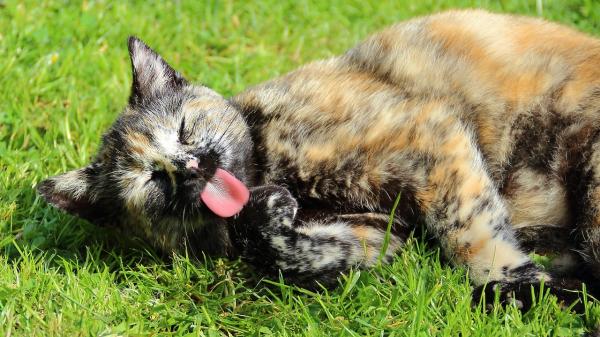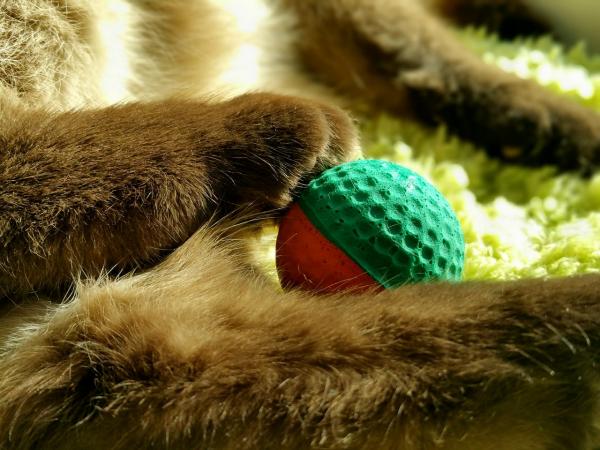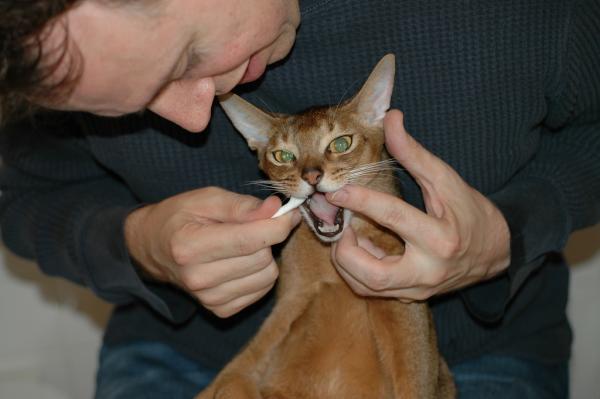Tips to remove tartar in cats

Maybe you’ve ever seen dirt in your cat’s mouth or even noticed bad breath. This is due to the accumulation of tartar on their teeth, because they are exactly the same as us with oral problems.
In this article we are going to give you some tips to remove tartar in cats and, in addition, we will inform you about what tartar is and how to prevent it.
What is tartar and what cats are more prone?
Such and how we have in the article on tips to remove scale in dogs, tartar is made up of stones formed by residues in the teeth of our pets. These residues that accumulate form the stones of tartar, are a mixture of bacterial plaque, food debris and mineral salts that accumulate throughout life in the mouth of our cats on a daily basis. The tartar is created especially in the space between the teeth and gums. If it is not treated in time, it is extended by the rest of oral structures, affecting them and even resulting in infections and secondary diseases more serious.
As with any disease, it is preferable to prevent tartar and its consequences have to deal with our hairy friend with mouth problems, because they can only be solved by subjecting the feline to general anesthesia to perform a professional mouth cleansing done by the veterinarian, in addition to the necessary medication treatment in each case.
All cats can suffer from tartar and its consequences, but some according to their health or age are more likely:
- Cats from three years tend to accumulate tartar. This is due to the fact that with three years of life they have been accumulating for a long time the aforementioned elements necessary for the production of tartar. If we do not help them to eliminate these harmful elements accumulated in their mouths, in a short time we will notice symptoms and detect diseases and problems derived from accumulated tartar.
- According to the quality of the feline’s teeth It can be that from a very young age it already has tartar. It happens the same as with people, because if genetically the denture of the individual is poor in the outer and protective layer called enamel, easily will adhere residues on the surface of the teeth and problems will quickly develop. The attention of the mouth care of the animals that suffer from this genetic defect is very important, because they themselves can not provide the constant and necessary cleaning, being very complicated to keep your mouth healthy without proper follow-up.

What consequences can tartar have for my cat?
Poor oral hygiene and the accumulation of tartar in our pets can bring many problems and diseases. These are the most common:
- Bad breath or halitosis: It is the first symptom that usually alerts us that tartar buildup is occurring in the mouths of our pets. It is a bad smell that comes from the decomposition of food waste accumulated between the teeth and gums. It can be detected at a certain distance from our pet when the problem is already beginning to be advanced. We must consult with our veterinarian to do an oral review to our cat and advise us what is the best way to help stop halitosis and prevent it from becoming tartar, because if we do not, in a short time it will continue complicating the problem and other diseases will be derived.
- Gingivitis: This disease begins when the presence of tartar begins in the mouths of our domestic cats. The gums become inflamed, redden and as the days go by they retract and finally the root of the affected tooth is discovered. This ends up being very painful for them and we must provide the treatment prescribed by our trusted veterinarian as soon as we detect any symptoms. If we do not do it soon, the exposed tooth root deteriorates rapidly and is reabsorbed. When the union between the tooth and the bone of the jaw or maxilla weakens so much, it ends up giving the total loss of the affected tooth and the exposure of the bone to secondary infections.
- Periodontal disease: This disease fits the previous two and continues to advance in the deterioration of the oral structures of the animal that suffers it, so that they continue to deteriorate the remaining teeth, their roots, the maxilla, the jaw, the palate, etc. When there is loss of teeth that have been affected, secondary infections occur in the gums and in the bones of the jaw and maxilla. What starts with tartar, halitosis and gingivitis ends up being a very serious problem that can cause the death of the animal. It also produces feline sufferers a huge pain that can lead them to stop eating very easily, in fact it is one of the symptoms that most alert us in the behavior of an animal affected by periodontal disease. The only way to combat this disease properly is to detect it as soon as possible, perform a professional mouth cleansing along with an antibiotic and anti-inflammatory treatment, in addition to an adequate follow-up. All this must be done by a veterinarian, since professional oral hygiene must be performed under general anesthesia and with adequate instruments, and only a veterinarian will know exactly what will be the appropriate treatment and will prescribe it to us.
- Secondary infections: All the problems and diseases described above if not treated in time and properly end up causing serious secondary infections in our furry friends. These infections are usually very serious, and can lead to heart, bowel, liver and kidney problems, therefore they carry a risk of death. Secondary infections that start in the gums or in the bones of the jaw or the maxilla, produce abscesses that continue advancing through the tissues of the mouth and that end up affecting the muzzle, nose and eyes of our pet.

How can we prevent tartar in domestic cats?
As we mentioned before, it is better to prevent tartar and the diseases that derive from it than to let our cat suffer them and have to treat it. These problems in our cat friends we can prevent them with oral hygiene guidelines and maintaining good health. As we do with ourselves, a good toothbrush, a mouthwash, monitor what foods we eat, among other things can help us avoid tartar and all that entails. Actually, as we will see, in oral health we do not differ so much from our four-legged friends.
Preventing the appearance of tartar will not only eliminate the possibility of a series of derived diseases and their consequences, but we will avoid enormous pain to our friend and we will even avoid anesthesia and drug treatments.
Some ways to prevent the appearance of tartar They are:
- Daily brushing: We must brush the teeth of our cat companion daily as we do with ours. It is better to accustom them from small so they adapt and facilitate the process. You have to choose a suitable toothbrush and a special toothpaste for cats. Later we will discuss in more detail how to carry out this tooth brushing in our pets.
- Toys and special prizes: There are toys, biscuits, bones and special feed that simply by playing or chewing our cats clean their mouths themselves and in a very simple as well as rewarding for them. These prizes and toys are composed of abrasive elements for the bacterial plaque that is found on the surface of our pet’s teeth. This will prevent the formation of tartar and, if there is already, we will help to soften it and eliminate it. Some of these materials are rubber or rope toys, bars, strips, cookies, feed with action oral care and bones, which we will find in stores for animals and veterinary centers.
- Maintenance of good physical health: It is vital that our friend has good health always and that if we detect symptoms of anything we take him to the vet. In order to maintain good health, it is essential that we offer our cat an adequate diet that is healthy and balanced. We must also ensure that you exercise enough to stay agile, active and healthy. All this will help us to keep many diseases and problems away from our four-legged companion.
- Observation of symptoms: As a prevention of more serious problems and diseases, it is vital that whenever we detect any symptom that may indicate problems in the mouth of our pet, we should contact the veterinarian immediately. Some of the most common symptoms and behaviors are:
- Excessive bad breath Halitosis is not only caused by accumulated tartar, gingivitis or periodontal disease. Therefore, it is very important that we go to our trusted veterinarian when we detect halitosis in our kitten. There are other diseases, such as those of the digestive system, which can cause bad breath. In addition, diabetes, kidney problems and parasitic diseases are other problems that can give this bad breath in our pets.
- Abundant salivation.
- Scratching your face or mouth frequently with your legs and objects such as sofas, walls, furniture, etc., without it seems at first glance that you have something that may bother you.
- Depression (lack of desire to eat, play, move, etc.)
- Stop eating or change the way you do it.
- Lack of teeth that we know that relatively recently were still.
- Sarro between the gums and the teeth.
- Loss of tooth quality with discoloration, partitioning or breakage of parts, etc.
- Gums inflamed, bleeding and red.
- Lumps, polyps or abscesses in the mouth of our cat.
- In advanced cases of periodontal disease, we will observe lumps and abscesses under the eyes, where the hairy friend’s snout begins.

Tips to prevent and remove tartar from the mouth of our pets
We want to give you useful tips so you can help your faithful companion to prevent oral diseases and to fight them in case they have appeared:
- Accustomed to tooth brushing. It is much better if we can do it every day but if it is not, with an average of three times a week should be enough to keep tartar to scratch. The easiest process to get our cat used to brushing his teeth every day is beginning to teach him since childhood. When still a small kitten we will pass a sterile gauze wet with water and rolled on our finger gently on the surface of the teeth every day. Later, when you are used to it, we should start teaching you the toothbrush and the special toothpaste for cats to become familiar with them. Then we will use the brush instead of the gauze and the specific paste instead of water. We will do the same, we will pass it gently on the surface of the teeth every day. At the beginning you can make the brushes shorter and little by little go making them longer as our partner is just getting used to. As cats swallow toothpaste instead of spitting it out like we do, we must use a special paste for cats that they sell in specialized stores for animals and in veterinary centers. It is a toothpaste that does not contain fluoride, which is highly toxic to them and therefore, we will never use a toothpaste for humans. It also comes in different flavors designed to make pasta nice for domestic cats. If we prefer not to use these toothpastes we can use Chlorhexidine that is sold in spray at veterinary centers and in specialized stores. This product is like our mouthwash that helps us to clean, disinfect, soften calculus stones and improve our breath. We must think about which brush is the most suitable for our cat, maybe one for small children already serves us or we can look in the pet shops for a model that fits better both our hairy and us to make it more comfortable.
- Teach your feline friend to have good eating habits. We know that many kittens only like to eat pates, muses and other soft food cans, which of course are delicious but are not the best for dental health. We must think that wet and soft food accumulates very easily in the nooks and crannies of cats’ mouths and it is difficult to eliminate these remains. Therefore, it is better that we habituate our companion animal to eat dry feed which will help to clean the teeth scratching the surface of these. From time to time as a reward we can offer them soft food cans, but never as basic or only food.
- Toys and special prizes. It is, as we mentioned before, balls, ropes and other toys, bars, bones, strips and feed among others, with abrasive components for the bacteria of dental plaque. You can buy them or you can make them yourself at home. These types of toys and prizes tend to enchant our pets, making them ideal for their full function of fun, food and oral care. Rope toys are very useful because when we chew them, our cat will be doing the same as we do with dental floss, but we must watch that they do not get too rid of and swallow the threads by accident, so if we see that the toy rope is already very damaged we will remove it by offering you a new one.
- Professional mouth cleaning: In case the scale accumulates a lot and we can not eliminate it with normal brushing, with toothpaste or chlorhexidine, with a diet or with toys, etc., we can only go to our veterinary specialist and that it becomes necessary to intervene to stop the process in time to develop other more serious secondary diseases such as those discussed earlier in this article. Even if it is already a periodontal disease we should also start the treatment to cure it with a good professional dental hygiene. The veterinarian should clean the mouth of our cat always under general anesthesia, with the help of an anesthetist and a veterinary assistant. With this process, tartar, food residues, bacterial plaque and mineral salts will be eliminated, with specific instruments for them, such as ultrasounds that serve to break tartar plates without damaging the enamel of the tooth. During the process, if there are some pieces of teeth that are badly damaged, they can get lost because they are irrecoverable. These teeth remain in the mouth because they have remained attached to the tartar, but they have long ceased to be functional and if they are left there they will end up producing lumps and abscesses followed by infections.
- Take advantage of general anesthesia to which you must subject your cat by obligation. It may be that due to other health issues or a simple sterilization, we are already forced to have our hairy go through a general anesthetic. As we know, it is not healthy to be under general anesthesia very often, so if we believe that our partner needs an oral hygiene made by the specialist will be responsible to discuss with our veterinarian if in the same operation under general anesthesia for which you should pass the cat for the important reason that it is, you can perform a professional mouth cleaning.

If you want to read more articles similar to Tips to remove tartar in cats, we recommend that you enter in our section of Dental Hygiene.


